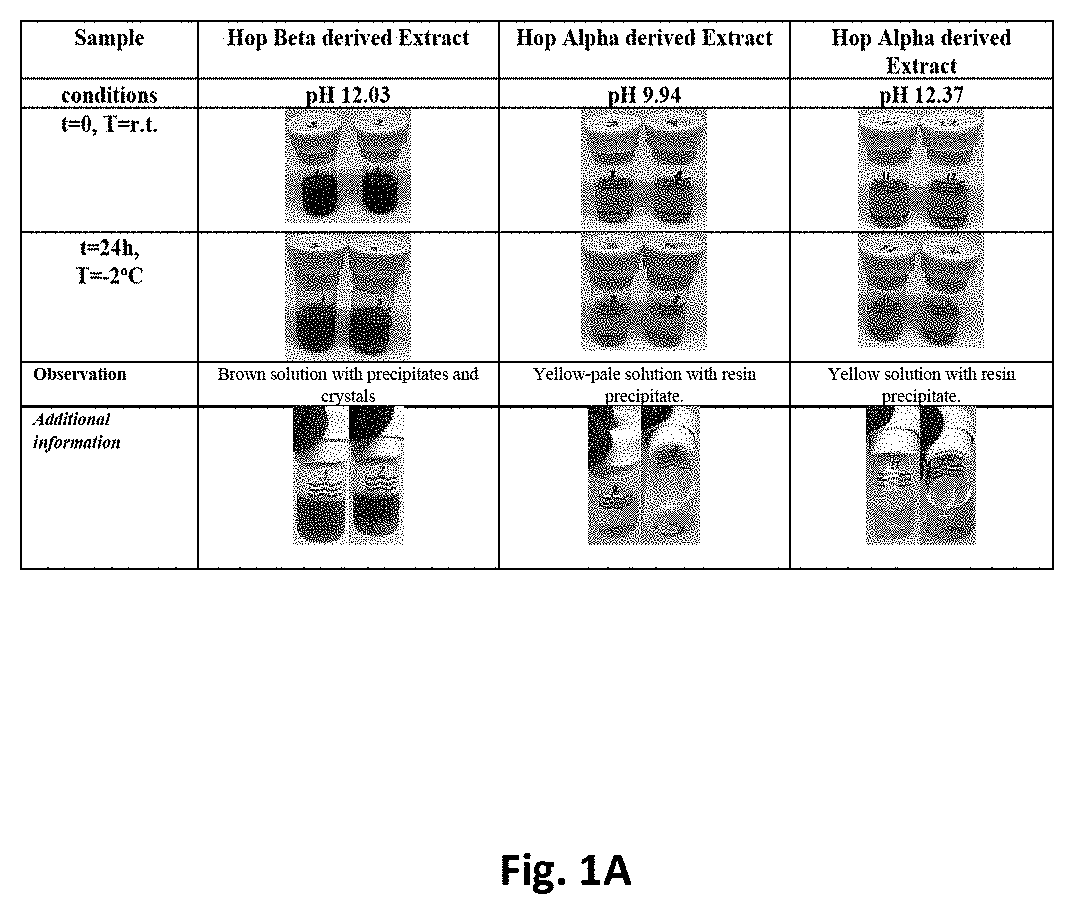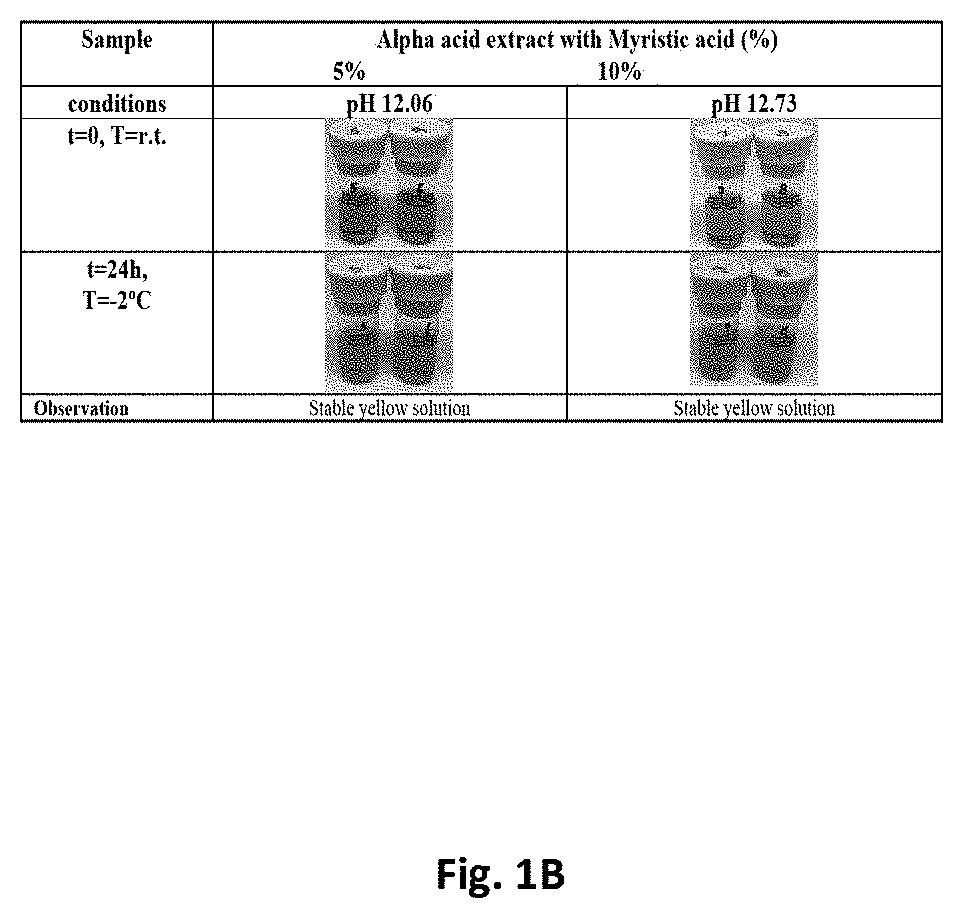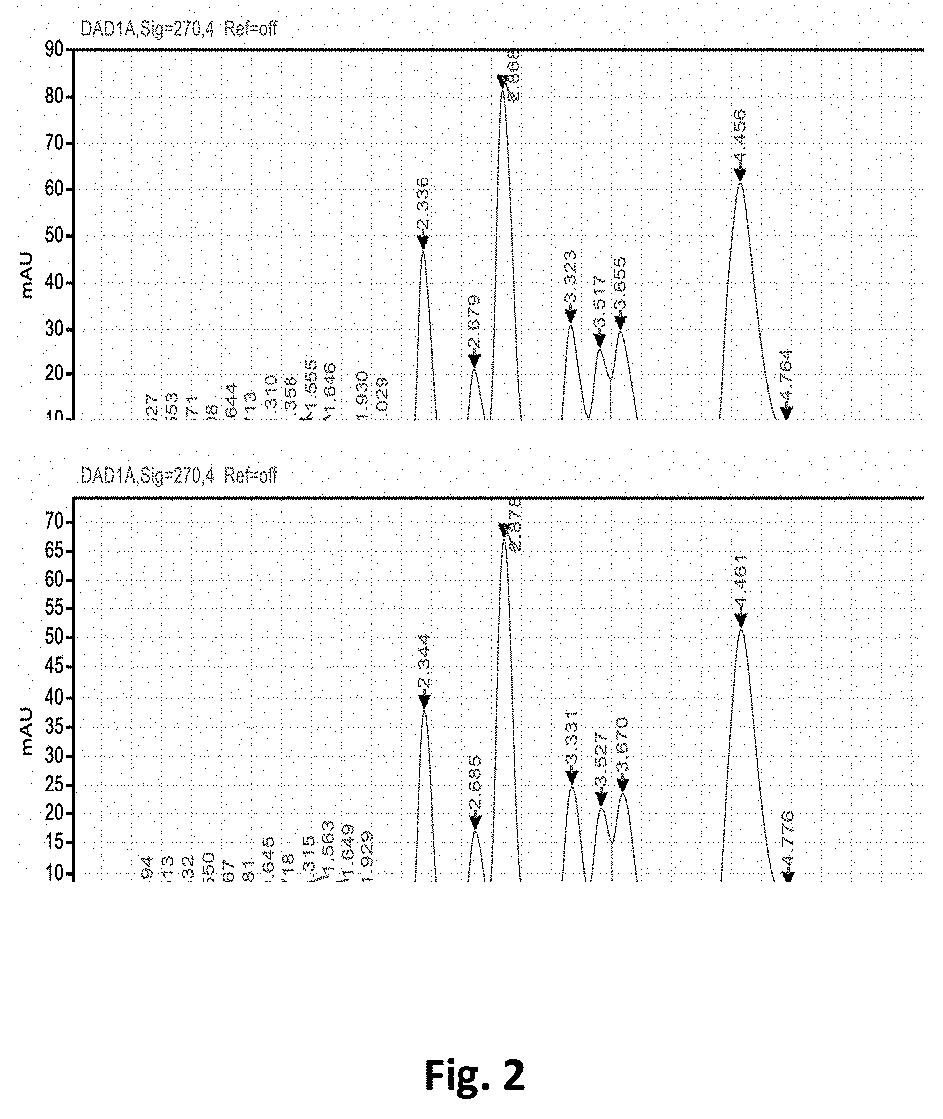Hop acids formulations and methods
a technology of hop acids and formulations, applied in the field of compositions and methods for improving hop acids, can solve the problems of inability to tolerate any such loss of production, high cost and time-consuming sterilization and loss of materials and production, and inability to reduce the cost of antibiotics and chemical disinfectants, so as to reduce and/or prevent the growth of microorganisms in the process
- Summary
- Abstract
- Description
- Claims
- Application Information
AI Technical Summary
Benefits of technology
Problems solved by technology
Method used
Image
Examples
example 1
Production of a 10% (W / W) Hop Alpha Acids Formulation with 1% (W / V) Myristic Acid
[0046]A compound comprising 10% (w / w) alpha acids and 1% (w / v) myristic acid was formulated as follows. 100 ml of alpha acids containing 50% hexa-hydro-iso-alpha acids (HHIAA) and 50% tetra-hydro-iso-alpha acids (THIAA) was heated to 60° C. To this solution was added 1.0109 g of myristic acid at 60° C. The pH of this suspension was adjusted to 10.71 using KOH. The solution was cooled to room temperature using an ice water bath, and the pH was measured to be 11.67. The concentration of hop alpha acids was determined by high performance liquid chromatography (HPLC), and measured to be 5% (w / w) hexa-hydro-iso-alpha acids and 4% (w / w) tetra-hydro-iso-alpha acids (see FIG. 2, top panel).
example 2
Comparison of Properties of 10% (W / W) Hop Alpha Acids Formulations with or without Myristic Acid
[0047]An alpha acid composition comprising about 10% (w / w) alpha acids and having pH of 8.31 at was cooled to 3° C. for 24 hours. A resin precipitate was apparent following this treatment. See FIG. 3, second column. An alpha acid composition comprising about 10% (w / w) alpha acids (having pH of 11.58 at room temperature) was cooled to 0° C. for 24 hours. A suspended precipitate was apparent following this treatment. See FIG. 3, third column, top image. A second sample of the same composition was cooled to −2° C. for 24 hours. A resin precipitate was apparent following this treatment. See FIG. 3, third column, bottom image. Another alpha derived composition comprising about 10% (w / w) alpha acids and (1% (w / v) myristic acid and having a pH of 11.67 was cooled to −12° C. No precipitate was observed to form following this treatment. See FIG. 3, fourth column.
example 3
Comparison of Properties of 9% (W / W) Hop Beta Acids Formulations and 10% (W / W) Hop Alpha Acids Formulations with Varying Amounts of Myristic Acid
[0048]A beta acid composition comprising about 9% (w / w) beta acids and about 10% (w / v) myristic acid and having a pH of 12.03 at room temperature was cooled to −2° C. for 24 hours. At −2° C., the composition was observed to form a precipitate and crystals. See FIG. 1A, second column.
[0049]Alpha acid compositions comprising about 10% (w / w) alpha acids were also tested. A composition having a pH of 9.94 was cooled to −2° C. for 24 hours. At −2 C, the composition formed a resin precipitate. After re-warming to room temperature, the resin precipitate persisted. See FIG. 1A, third column. Similar results were obtained for an alpha acid composition having a pH of 12.37 at room temperature. See FIG. 1A, fourth column.
[0050]Alpha acid compositions comprising about 10% (w / w) alpha acids and varying amounts of myristic acid were then tested. The alph...
PUM
 Login to View More
Login to View More Abstract
Description
Claims
Application Information
 Login to View More
Login to View More - R&D
- Intellectual Property
- Life Sciences
- Materials
- Tech Scout
- Unparalleled Data Quality
- Higher Quality Content
- 60% Fewer Hallucinations
Browse by: Latest US Patents, China's latest patents, Technical Efficacy Thesaurus, Application Domain, Technology Topic, Popular Technical Reports.
© 2025 PatSnap. All rights reserved.Legal|Privacy policy|Modern Slavery Act Transparency Statement|Sitemap|About US| Contact US: help@patsnap.com



